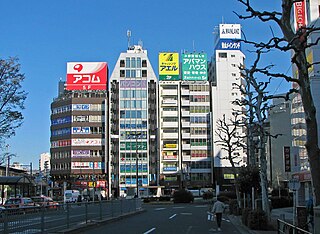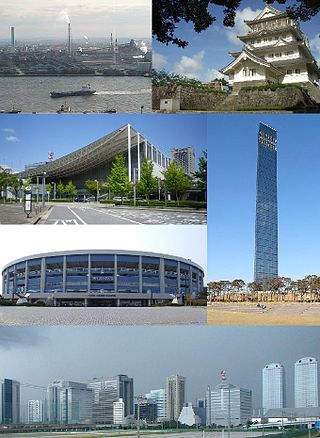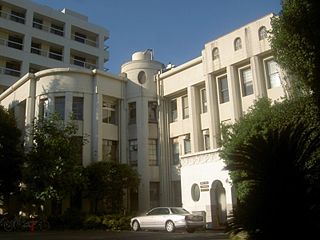
Shinjuku, officially called Shinjuku City, is a special ward in the Tokyo Metropolis in Japan. It is a major commercial and administrative center, housing the northern half of the busiest railway station in the world and the Tokyo Metropolitan Government Building, the administration center for the government of Tokyo. As of 2018, the ward has an estimated population of 346,235 and a population density of 18,232 people per km2. The total area is 18.23 km2. Since the end of World War II, Shinjuku has been a major secondary center of Tokyo (fukutoshin), rivaling the original city center in Marunouchi and Ginza.

Shibuya is a special ward in Tokyo, Japan. A major commercial and finance center, Shibuya houses two of the busiest railway stations in the world, Shinjuku Station and Shibuya Station.

Special wards are a special form of municipalities in Japan under the 1947 Local Autonomy Law. They are city-level wards: primary subdivisions of a prefecture with municipal autonomy largely comparable to other forms of municipalities.

Aoyama (青山) is one of the wealthiest neighborhoods of Tokyo, located in the northwest portion of Minato Ward. The area is well known for its international fashion houses, cafes and restaurants.

Ebisu (恵比寿) is major district of Shibuya-ku in Tokyo, Japan. It was developed on the site of a former brewery and is now home to Yebisu Garden Place. It has a high concentration of bars and restaurants.

Hiroo Station is a subway station on the Hibiya Line in Minato, Tokyo operated by the Tokyo subway operator Tokyo Metro. The station is named after the adjacent Hiroo neighborhood in Shibuya ward, though the station is entirely located in Minami-Azabu.

Gotanda (五反田) is a district in the Shinagawa ward of Tokyo, Japan. The district straddles the Meguro River, and is located between the Meguro and Ōsaki stations on the JR Yamanote Line.

Princess Yōko of Mikasa is a member of the Imperial House of Japan and the second daughter of Prince Tomohito of Mikasa and Princess Tomohito of Mikasa (Nobuko). She is also the niece of Japan's 92nd prime minister Tarō Asō, great-niece of author and literary critic Ken'ichi Yoshida, and great-granddaughter of Japan's 45th prime minister Shigeru Yoshida.
The Japanese Nursing Association (JNA) (日本看護協会, Nihon Kango Kyoukai) is the national professional association for midwives and nurses in Japan. It governs all subordinate nursing associations with jurisdiction in each of the 47 prefectures of Japan.

Chiba is the capital city of Chiba Prefecture, Japan. It sits about 40 kilometres (25 mi) east of the centre of Tokyo on Tokyo Bay. The city became a government-designated city in 1992. In June 2019, its population was 979,768, with a population density of 3,605 people per km2. The city has an area of 271.77 square kilometres (104.93 sq mi).

Tokyo Medical University is a private medical university located in Shibuya, Tokyo, Japan. Established in 1916, it is one of the medical schools established in Japan before World War II.

Higashi (東) is a residential district of the Shibuya ward in Tokyo surrounded by the residential areas of Hiroo, Ebisu, Daikanyama and Aoyama. Prince Hitachi and Princess Hitachi have their official residence in a palace in large gardens off Komazawadori in Higashi.

Nagatsuta Station is an interchange passenger railway station located in Midori-ku, Yokohama, Kanagawa Prefecture, Japan, jointly operated by East Japan Railway Company, Tokyu Corporation, and the Yokohama Minatomirai Railway.

Hiroo (広尾) is a district of Shibuya, Tokyo, Japan. Abutting Ebisu, Minami-Azabu, Nishi-Azabu and Minami-Aoyama, Hiroo is an upmarket residential and shopping neighborhood in central Tokyo.

Japanese Red Cross College of Nursing is a private university in Hiroo, Shibuya, Tokyo, Japan with an auxiliary suburban campus in Musashino, Tokyo.

The Embassy of the Sultanate of Oman in Tokyo, Japan is the Sultanate of Oman's diplomatic mission to Japan since 1979. The Ambassador is HE Dr. Mohamed Said Al Busaidi, who will also be Oman's non-resident Ambassador to Australia and New Zealand. The Embassy is located at 4-2-17 Hiroo, Shibuya-ku, Tokyo 150-0012, Japan.

The British School in Tokyo is an international school in central Tokyo with over 1,100 students from over 65 nationalities. BST takes students aged 3–18 that have been rated in all eight areas examined by the Independent Schools Inspectorate (ISI). A third of BST students are neither British nor Japanese and there are no entry requirements other than fluency in English. The curriculum follows the National Curriculum.

Tokyo Metropolitan Hiroo Hospital (東京都立広尾病院) is a public hospital in Shibuya, Tokyo, Japan. It has 426 beds and is run by the Tokyo Metropolitan Government.


















